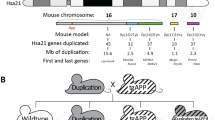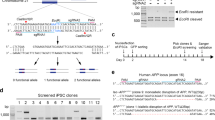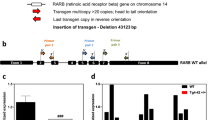Abstract
Overexpression of the gene encoding the β–amyloid precursor protein (APP) may have a key role in the pathogenesis of both Alzheimer's disease (AD) and Down Syndrome (DS). We have therefore introduced a 650 kilobase (kb) yeast artificial chromosome (YAC) that contains the entire, unrearranged 400 kb human APP gene into mouse embryonic stem (ES) cells by lipid–mediated transfection. ES lines were generated that contain a stably integrated, unrearranged human APP gene. Moreover, we demonstrate germ line transmission of the APP YAC in transgenic mice and expression of human APP mRNA and protein at levels comparable to endogenous APP. This transgenic strategy may prove invaluable for the development of mouse models for AD and DS.
This is a preview of subscription content, access via your institution
Access options
Subscribe to this journal
Receive 12 print issues and online access
$209.00 per year
only $17.42 per issue
Buy this article
- Purchase on Springer Link
- Instant access to full article PDF
Prices may be subject to local taxes which are calculated during checkout
Similar content being viewed by others
References
Giaccone, G. et al. Down patients: extracellular preamyloid deposits precede neuritic degeneration and senile plaques. Neurosci. Lett. 97, 232–238 (1989).
Glenner, G.G. & Wong, C.W. Alzheimer's disease: initial report of the purification and characterization of a novel cerebrovascular amyloid protein. Biochem. Biophys. Res. Commun. 120, 885–890 (1984).
Masters, C.L. et al. Amyloid plaque core protein in Alzheimer disease and Down syndrome. Proc. natn. Acad. Sci. U.S.A. 82, 4245–4249 (1985).
Masters, C.L. et al. Neuronal origin of a cerebral amyloid: neurofibrillary tangles of Alzheimer's disease contain the same protein as the amyloid of plaque cores and blood vessels. EMBO J. 4, 2757–2763 (1985).
Kemper, T. Neuroanatomical and neuropathological changes in normal aging and in dementia. In Clinical Neurology of Aging (ed. Albert, M.L.) 9–52 (Oxford University Press, New York, 1984).
Selkoe, D.J., Bell, D.S., Podlisny, M.B., Price, D.L. & Cork, L.C. Conservation of brain amyloid proteins in aged mammals and humans with Alzheimer's disease. Science 235, 873–877 (1987).
Mann, D.M. & Esiri, M.M. The pattern of acquisition of plaques and tangles in the brains of patients under 50 years of age with Down's syndrome. J. neurol. Sci. 89, 169–179 (1989).
Rumble, B. et al. Amyloid A4 protein and its precursor in Down's syndrome and Alzheimer's disease. New Engl. J. Med. 320, 1446–1452 (1989).
Goldgaber, D., Lerman, M.I., McBride, O.W., Saffiotti, U. & Gajdusek, D.C. Characterization and chromosomal localization of a cDNA encoding brain amyloid of Alzheimer's disease. Science 235, 877–880 (1987).
Kang, J. et al. The precursor of Alzheimer's disease amyloid A4 protein resembles a cell-surface receptor. Nature 325, 733–736 (1987).
Tanzi, R.E. et al. Amyloid β protein gene: cDNA, mRNA distribution, and genetic linkage near the Alzheimer locus. Science 235, 880–884 (1987).
Yoshikai, S., Sasaki, H., Doh-ura, K., Furuya, H. & Sakaki, Y. Genomic organization of the human amyloid β-protein precursor gene. Gene 87, 257–263 (1990).
Ponte, P. et al. A new A4 amyloid mRNA contains a domain homologous to serine proteinase inhibitors. Nature 331, 525–527 (1988).
Golde, T.E., Estus, S., Usiak, M., Younkin, L.H. & Younkin, S.G. Expression of β amyloid protein precursor mRNAs: recognition of a novel alternatively spliced form and quantitation in Alzheimer's disease using PCR. Neuron 4, 253–267 (1990).
Weidemann, A. et al. Identification, biogenesis, and localization of precursors of Alzheimer's disease A4 amyloid protein. Cell 57, 115–26 (1989).
Haass, C., Koo, E.H., Mellon, A., Hung, A.Y. & Selkoe, D.J. Targeting of cell-surface β-amyloid precursor protein to lysosomes: alternative processing into amyloid-bearing fragments. Nature 357, 500–503 (1992).
Sisodia, S.S. β-Amyloid precursor protein cleavage by a membrane-bound protease. Proc. natn. Acad. Sci. U.S.A. 89, 6075–6079 (1992).
Esch, F.S. et al. Cleavage of amyloid β peptide during constitutive processing of its precursor. Science 248, 1122–4 (1990).
Sisodia, S.S., Koo, E.H., Beyreuther, K., Unterbeck, A. & Price, D.L. Evidence that β-amyloid protein in Alzheimer's disease is not derived by normal processing. Science 248, 492–5 (1990).
Anderson, J.P. et al. Exact cleavage site of Alzheimer amyloid precursor in neuronal PC–12 cells. Neurosci. Lett. 128, 126–128 (1991).
Wang, R., Meschia, J.F., Cotter, R.J. & Sisodia, S.S. Secretion of the β/A4 amyloid precursor protein. Identification of a cleavage site in cultured mammalian cells. J. biol. Chem. 266, 16960–16964 (1991).
Golde, T.E., Estus, S., Younkin, L.H., Selkoe, D.J. & Younkin, S.G. Processing of the amyloid protein precursor to potentially amyloidogenic derivatives. Science 255, 728–730 (1992).
Haass, C. et al. Amyloid β-peptide is produced by cultured cells during normal metabolism. Nature 359, 322–325 (1992).
Seubert, P. et al. Isolation and quantification of soluble Alzheimer's β-peptide from biological fluids. Nature 359, 325–327 (1992).
Shoji, M. et al. Production of the Alzheimer amyloid β protein by normal proteolytic processing. Science 258, 126–129 (1992).
Selkoe, D.J. The molecular pathology of Alzheimer's disease. Neuron 6, 487–498 (1991).
Price, D.L., Walker, L.C., Martin, L.J. & Sisodia, S.S. Amyloidosis in aging and Alzheimer's disease. Am. J. Pathol. 141, 767–772 (1992).
Sisodia, S.S. & Price, D.L. Amyloidogensis in Alzheimer's disease: basic biology and animal models. Curr. Opin. Neurobiol. 2, 648–652 (1992).
Chartier-Harlin, M.C. et al. Early-onset Alzheimer's disease caused by mutations at codon 717 of the β-amyloid precursor protein gene. Nature 353, 844–846 (1991).
Goate, A. et al. Segregation of a missense mutation in the amyloid precursor protein gene with familial Alzheimer's disease. Nature 349, 704–706 (1991).
Murrell, J., Farlow, M., Ghetti, B. & Benson, M.D. A mutation in the amyloid precursor protein associated with hereditary Alzheimer's disease. Science 254, 97–99 (1991).
Naruse, S. et al. Mis-sense mutation val-ile in exon-17 of amyloid precursor protein gene in Japanese familial Alzheimer's disease. Lancet 337, 978–979 (1991).
Mullan, M. et al. A pathogenetic mutation for probable Alzheimer's disease in the APP gene at the N-terminus of β-amyloid. Nature Genet. 1, 345–347 (1992).
Levy, E. et al. Mutation of the Alzheimer's disease amyloid gene in hereditary cerebral hemorrhage, Dutch type. Science 248, 1124–1126 (1990).
Van Broeckhoven, C. et al. Amyloid β protein precursor gene and hereditary cerebral hemorrhage with amyloidosis (Dutch). Science 248, 1120–1122 (1990).
Hendriks, L. et al. Presenile dementia and cerebral haemorrhage linked to a mutation at codon 692 of the β-amyloid precursor protein gene. Nature Genet. 1, 218–221 (1992).
Kawabata, S., Higgins, G.A. & Gordon, J.W. Amyloid plaques, neurofibrillary tangles and neuronal loss in brains of transgenic mice overexpressing a C-terminal fragment of human amyloid precursor protein. Nature 354, 476–478 (1991). Retracted, Nature 356, 23 (1992).
Quon, D. et al. Formation of β-amyloid protein deposits in brains of transgenic mice. Nature 352, 239–41 (1991).
Wirak, D.O. et al. Deposits of amyloid β protein in the central nervous system of transgenic mice. Science 253, 323–325 (1991). Retracted, Science 255, 1445 (1992).
Kammesheidt, A. et al. Deposition of β/A4 immunoreactivity and neuronal pathology in transgenic mice expressing the carboxyl-terminal fragment of the Alzheimer amyloid precursor in the brain. Proc. natn. Acad. Sci. U.S.A. 89, 10857–10861 (1992).
Brinster, R.L., Allen, J.M., Behringer, R.R., Gelinas, R.E. & Palmiter, R.D. Introns increase transcriptional efficiency in transgenic mice. Proc. natn. Acad. Sci. U.S.A. 85, 836–840 (1988).
Schedl, A., Montoliu, L., Kelsey, G. & Schutz, G. A yeast artificial chromosome covering the tyrosinase gene confers copy number-dependent expression in transgenic mice. Nature 362, 258–261 (1993).
Jakobovits, A. et al. Germ-line transmission and expression of a human-derived yeast artificial chromosome. Nature 362, 255–258 (1993).
Choi, T.K. et al. Transgenic mice containing a human heavy chain immunoglobulin gene fragment cloned in a yeast artificial chromosome. Nature Genet. 4, 117–123 (1993).
Strauss, W.M. et al. Germ-line transmission of a yeast artificial chromosome spanning the murine Col1A1 (a 1 (I)Collagen) locus. Science 259, 1904–1907 (1993).
Chumakov, I. et al. Continuum of overlapping clones spanning the entire human chromosome 21q. Nature 359, 380–387 (1992).
Hieter, P. et al. Yeast artificial chromosomes: promises kept and pending. In Genome Analysis Volume I: Genetic and Physical Mapping (eds Davies, K.E. & Tilghman, S.) 83–120 (Cold Spring Harbor Laboratory Press, New York, 1990).
Jucker, M. et al. Age-associated inclusions in normal and transgenic mouse brain. Science 255, 1443–1445 (1992).
Bradley, A. Production and analysis of chimeric mice. In Teratocarcinomas and Embryonic Stem Cells: A Practical Approach (ed. Robertson, E.J.) 113–151 (IRL Press, Oxford, 1987).
Robertson, E.J. Embryo-derived stem cell lines. In Teratocarcinomas and Embryonic Stem Cells: A Practical Approach (ed. Robertson, E.J.) 71–112 (IRL Press, Oxford, 1987).
Smith, A.G. et al. Inhibition of pluripotential embryonic stem cell differentiation by purified polypeptides. Nature 336, 688–690 (1988).
Miller, S.A., Dykes, D.D. & Polesky, H.F. A simple salting out procedure for extracting DNA from human nucleated cells. Nucl. Acid Res. 16, 1215 (1988).
Gardiner, K., Laas, W. & Patterson, D. Fractionation of large mammalian DNA restriction fragments using vertical pulsed-field gradient gel electrophoresis. Som. Cell Molec. Genet. 12, 185–195 (1986).
Anand, R., Villasante, A. & Tyler-Smith, C. Construction of yeast artificial chromosome libraries with large inserts using fractionation by pulsed-field gel electrophoresis. Nucl. Acids Res. 17, 3425–3433 (1989).
Davis, R.W. et al. Rapid DNA isolations for enzymatic and hybridization analysis. Methods Enzymol. 65, 404–411 (1980).
Soriano, P., Montgomey, C., Geske, R. & Bradley, A. Targeted disruption of the c-src proto-oncogene leads to osteopetrosis in mice. Cell 64, 693–702 (1991).
Linney, E. & Donerly, S. DNA from F9 PyEC mutants increase expression of heterologous genes in transfected F9 cells. Cell 35, 693–699 (1983).
Lamb, B.T., Satyamoorthy, K., Li, L., Solter, D. & Howe, C.C. CpG methylation of an endogenous retroviral enhancer inhibits transcription factor binding and activity. Gene Exp. 1, 185–196 (1991).
Connelly, C., McCormick, M.K., Shero, J. & Hieter, P. Polyamines eliminate an extreme size bias against transformation of large yeast artificial chromosome DNA. Genomics 10, 10–16 (1991).
Ito, H., Fukuda, Y., Murata, K. & Kumura, A. Transformation of intact cells treated with alkali cations. J. Bacteriol. 153, 163–168 (1983).
Sisodia, S.S., Sollner-Webb, B. & Cleveland, D.W. Specificity of RNA maturation pathways: RNAs transcribed by RNA polymerase III are not substrates for splicing or polyadenylation. Molec. cell. Biol. 7, 3602–3612 (1987).
Feinberg, A.P. & Vogelstein, B. A technique for radiolabelling DNA restriction endonuclease fragments to high specific activity. Anal. Biochem. 137, 266–267 (1984).
Yoshikai, S., Sasaki, H., Doh-ura, K., Furuya, H. & Sakaki, Y. Genomic organization of the human amyloid β-protein precursor gene corrigendum. Gene 102, 291–292 (1991).
Tassone, F., Cheng, S. & Gardiner, K. Analysis of chromosome 21 yeast artificial chromosome (YAC) clones. Am. J. hum. Genet. 51, 1251–1264 (1992).
Wirak, D.O. et al. Regulatory region of human amyloid precursor protein (APP) gene promotes neuron-specific gene expression in the CNS of transgenic mice. EMBO J. 10, 289–96 (1991).
Author information
Authors and Affiliations
Rights and permissions
About this article
Cite this article
Lamb, B., Sisodia, S., Lawler, A. et al. Introduction and expression of the 400 kilobase precursor amyloid protein gene in transgenic mice. Nat Genet 5, 22–30 (1993). https://doi.org/10.1038/ng0993-22
Received:
Accepted:
Issue Date:
DOI: https://doi.org/10.1038/ng0993-22
This article is cited by
-
Applications and considerations for the use of genetically engineered mouse models in drug development
Cell and Tissue Research (2020)
-
SLIM microscopy allows for visualization of DNA-containing liposomes designed for sperm-mediated gene transfer in cattle
Molecular Biology Reports (2019)
-
Practical considerations for choosing a mouse model of Alzheimer’s disease
Molecular Neurodegeneration (2017)
-
The infectious BAC genomic DNA expression library: a high capacity vector system for functional genomics
Scientific Reports (2016)
-
Tau-induced neurodegeneration: mechanisms and targets
Neuroscience Bulletin (2014)



